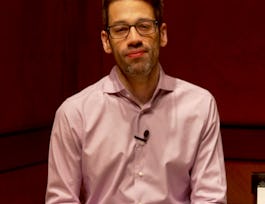In many ways Scandinavian film and television is a global cultural brand, connected with and exporting some of the cultural and social values connected to a liberal and progressive welfare society. This course deals with the social, institutional and cultural background of film and television in Scandinavia and in a broader European and global context.


Scandinavian Film and Television
Taught in English
Some content may not be translated
23,683 already enrolled
(579 reviews)
Details to know

Add to your LinkedIn profile
10 quizzes
See how employees at top companies are mastering in-demand skills


Earn a career certificate
Add this credential to your LinkedIn profile, resume, or CV
Share it on social media and in your performance review

There are 5 modules in this course
This module consists of two lessons. The first lesson offers an introduction to main trends in the contemporary Scandinavian film and television culture, focusing – among other things – on how the national film and television cultures relate to ideas of the welfare state. The module also addresses the international impact of film and television from Scandinavia. The second lesson deals with the early years of cinema in Scandinavia and the work of the Danish director Carl Th. Dreyer, from a silent film classic such as 'The Passion of Joan of Arc' to the sound film era.
What's included
6 videos2 readings2 quizzes3 discussion prompts
'The Seventh Seal', 'Persona' and 'Cries and Whispers' are just some of the famous films by the acclaimed Swedish director Ingmar Bergman. The third lesson focuses on issues of influences, themes and style in his films as well as on Bergman's importance for the modern art cinema. The fourth lesson deals with the internationally renowned ideas and films by the Danish director Lars von Trier: 'The Europa-trilogy'; The TV series 'Riget'/'The Kingdom'; 'Breaking the Waves'; 'Dancer in the Dark' and 'Dogville'; The Dogma 95 Manifesto; 'Antichrist', 'Melancholia' and 'Nymphomaniac' ...
What's included
6 videos2 readings2 quizzes3 discussion prompts
Many people have heard of the French new wave cinema, 'la nouvelle vague'. The fifth lesson deals with the main tendencies of the Scandinavian new wave cinema and some of its 'auteurs'. The sixth lesson focuses on different tendencies in the Scandinavian art film and social drama after 1990, ranging from award-winning heritage films to harsh stories from the contemporary Scandinavian welfare societies.
What's included
6 videos2 readings2 quizzes
Scandinavian cinema has a long history of strong documentary film making. The seventh lesson moves from the early documentary filmmakers to the contemporary – global and digital – scene for Scandinavian documentaries. Television drama is important for the Scandinavian public service broadcasters, but the notions of good television drama have changed remarkably from the early days of television up until today. In the eighth lesson we focus on the main tendencies in these developments from 1960 to 2000.
What's included
6 videos2 readings2 quizzes
With 'Nordic Noir' such as 'Wallander' and 'Forbrydelsen/The Killing' becoming a 'brand' in the 2010s, some 'Scandi crime' series were suddenly of interest to international as well as national audiences. The ninth lesson focuses on Scandinavian television drama after the millennium and addresses some of the changes in the production framework that helped the series move from the national to the international realm. The tenth and final lesson discusses how to understand the contemporary Scandinavian film and television culture in a global and digital era. What might the transnational future bring? (Please be advised that these lectures were filmed in 2014. Much has happened since then. We have put links about more recent developments in the resources.)
What's included
6 videos8 readings2 quizzes
Instructor

Offered by
Recommended if you're interested in Music and Art

Curtis Institute of Music

University of Rochester

Alfaisal University | KLD

Alfaisal University | KLD
Why people choose Coursera for their career




Learner reviews
Showing 3 of 579
579 reviews
- 5 stars
76.55%
- 4 stars
18.10%
- 3 stars
3.10%
- 2 stars
1.20%
- 1 star
1.03%

Open new doors with Coursera Plus
Unlimited access to 7,000+ world-class courses, hands-on projects, and job-ready certificate programs - all included in your subscription
Advance your career with an online degree
Earn a degree from world-class universities - 100% online
Join over 3,400 global companies that choose Coursera for Business
Upskill your employees to excel in the digital economy
Frequently asked questions
Access to lectures and assignments depends on your type of enrollment. If you take a course in audit mode, you will be able to see most course materials for free. To access graded assignments and to earn a Certificate, you will need to purchase the Certificate experience, during or after your audit. If you don't see the audit option:
The course may not offer an audit option. You can try a Free Trial instead, or apply for Financial Aid.
The course may offer 'Full Course, No Certificate' instead. This option lets you see all course materials, submit required assessments, and get a final grade. This also means that you will not be able to purchase a Certificate experience.
When you purchase a Certificate you get access to all course materials, including graded assignments. Upon completing the course, your electronic Certificate will be added to your Accomplishments page - from there, you can print your Certificate or add it to your LinkedIn profile. If you only want to read and view the course content, you can audit the course for free.
You will be eligible for a full refund until two weeks after your payment date, or (for courses that have just launched) until two weeks after the first session of the course begins, whichever is later. You cannot receive a refund once you’ve earned a Course Certificate, even if you complete the course within the two-week refund period. See our full refund policy.


